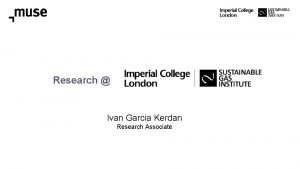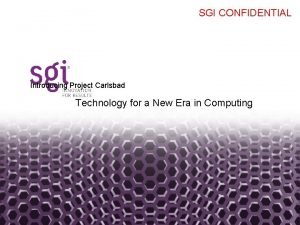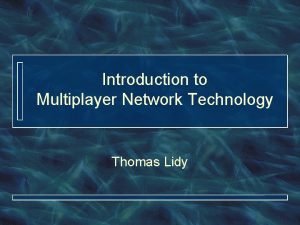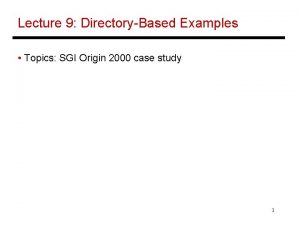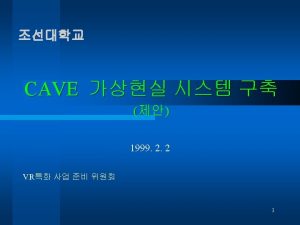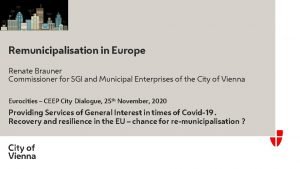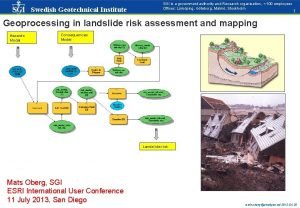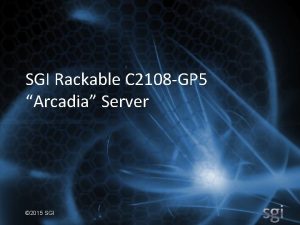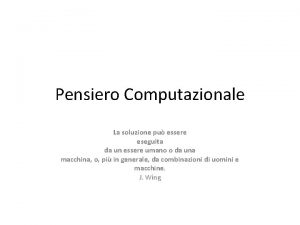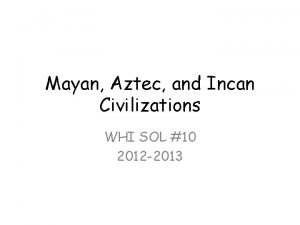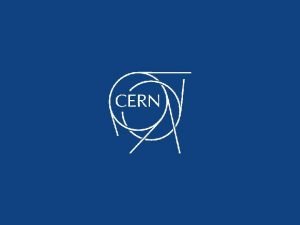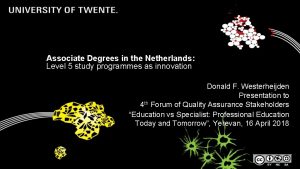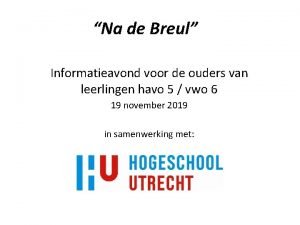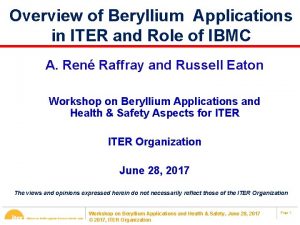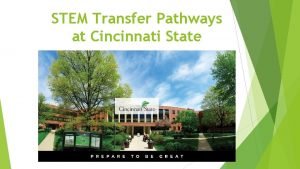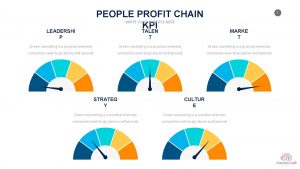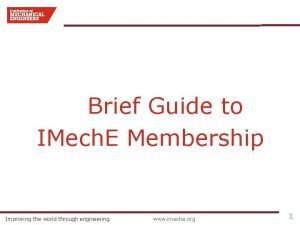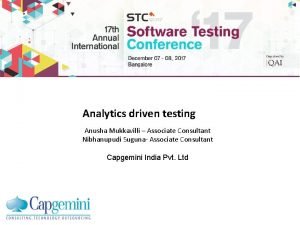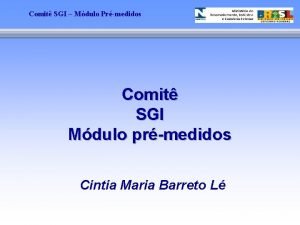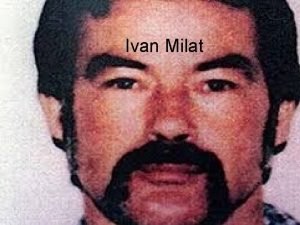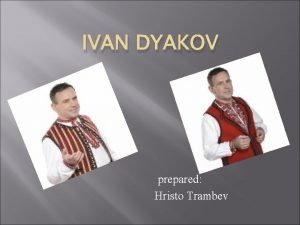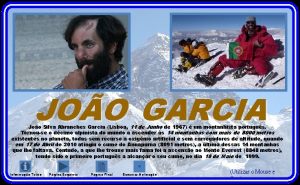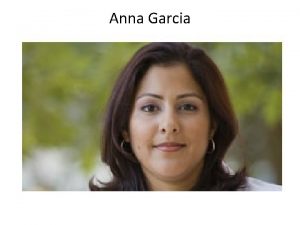Research Ivan Garcia Kerdan Research Associate Contents SGI









































- Slides: 41

Research @ Ivan Garcia Kerdan Research Associate

Contents • SGI scope • What do we do? • White paper series • MUSE – A novel Integrated Assessment Model Applications

Prof Nigel Brandon Co-director Dr Adam Hawkes Co-director Dr Marina Lomberg Operations Manager Dr Jamie Speirs Research Fellow Dr Paul Balcombe Research Fellow Dr Sara Giarola Dr Daniel Crow Research Fellow Research Associate Dr Julia Sachs Research Associate Zara Qadir Prof Velisa Vesovic Communications Manager Theme Lead - LNG Dr Jasmin Cooper Research Associate Dr Sara Budinis Research Associate Prof Anna Korre Theme Lead - EIA Dr Francisca Jalil Vega Research Associate Dr Ivan Garcia Kerdan Research Associate Mr Cheng-Ta Chu Ph. D Student Mr Diego Moya Ph. D Student

SGI-Imperial Aims CHALLENGES New sources of natural gas R AS MA G E R U FUT Climate change and carbon budget KET • Launched in May 2014. Unique academic-industry partnership (Shell and Imperial College London) • Examine the environmental, economic and technological role of natural gas in the global energy landscape. • Address the global challenge of how industry can mitigate climate change. • Define the technologies and develop energy systems models that could explore the role of gas in the energy landscape. • Help to advance technology roadmaps to support future R&D investment decisions.

What do we do? I. Deliver evidence based white papers that inform the debate around the role of natural gas. II. Developing a methane research programme III. Developing a novel Integrated Assessment Simulation tool (MUSE) to analyse the global energy system and land use, and the role of technologies within it.

The SGI White Paper Series • Evidence-based reviews targeted at a global audience of policy/decision makers and industry • Provide clarity to contentious topics in the energy sector and help inform debate around natural gas. • A systematic review of the contemporary evidence base and primary analysis. • Each paper begins with a published scoping note. • Reviewed by an international expert group. • Published online with a short two-page summary. www. sustainablegasinstitute. org/white_paper_series/

WP 1

WP 2 (modified from Mc. Glade and Ekins 2015).

WP 3

Integrated Assessment Models ●Researchers have relied heavily on IAMs to explore decarbonisation pathways IPCC 5 th Assessment Report - 1, 184 scenarios were produced from 31 whole system models - Quantitative basis for working group 3 conclusions (mitigation) ●The ultimate goal of the process is scientific credibility, public acceptance, and political and legal viability. ●Research community improving how it reports and handles the wide range of uncertainty from IAM‐based calculations Source: Fuss et al (2014) Betting on negative emissions. Nature Climate Change 4, 850– 853

MUSE: why and how? Why a new model? Among the available models, there is often lack of clarity on the input assumptions and flexibility q Bringing engineering reality to systems-level modelling q Better insight for the energy industry (e. g. O&G on upstream opportunities) q The need for transparency in methods, assumptions and results How? o Simulation not optimisation o Flexible sector modules – entirely new approach o Imperfect foresight – simulate real decision making o Open-access, clear communication, credibility Applications: Ø Understanding the role of gas in low carbon energy systems Ø R&D prioritisation of value and role of technologies Ø Strategy and business model development against a variety of scenarios Ø Climate change mitigation pathways assessment (i. e. long-term)

Mod. Ular energy system Simulation Environment ● Partial equilibrium on the energy system (models supply and demand) ● Covers all the sectors in the energy system ● Bottom-up and technology rich ● Microeconomic foundations: all sectors agree on price and quantity for each energy commodity ● Hybrid and modular; methodology in each sector is appropriate for that sector ● Agent-based modelling: Identifies the key agents in each sector and models ● SSP 2 used for service projections ● Trade ● Will be open-source

Open model Open source AIM/Enduse Minimise system cost Inter-temporal Optimise tech. investments and operation High Perfect Global (32) ESME Minimise system cost Inter-temporal Optimise tech. investments and operation Med. Perfect UK (12) GCAM Simulate market equilibrium Recursive dynamic Market clearing with cost-based tech. sharing High Myopic Global (14) IMACLIM Simulate economic growth Recursive dynamic general equilibrium Low Myopic Global (12) IMAGETIMER Simulate market equilibrium Recursive dynamic Market clearing with hybrid sector simulation Int. Myopic Global (26) MERGE Maximise profit/utility Inter-temporal general equilibrium Low Perfect Global (12) MUSE Simulate market equilibrium Recursive dynamic Market clearing with hybrid sector simulation High Limited Global (28) NEMS Simulate market equilibrium Recursive dynamic Market clearing with hybrid sector simulation High Limited USA (9) PRIMES Simulate market equilibrium Recursive dynamic Market clearing , utility/profit maximising High Limited EU+ (35) REMIND Maximise welfare Inter-temporal general equilibrium Low Global (11) TIMES-ED Maximise surplus Inter-temporal Optimise tech. investments and operation High Perfect Various WITCH Simulate economic growth Inter-temporal Non-cooperative Nash game Low Global (12) Perfect Myopic Geo scope (no. of regions) Method description Foresight Temporal Solver characteristics Tech. detail Overall solution aim Model

Open source/open access Software o Simulation model developed in Python Git. Hub repository o Collaborative, agile software development o Private and (ultimately) public versions Open source o Tools and methodology for any team to build their own MUSE or integrate to a third party modelling environment

15

Time characterisation • Time goes from 2010 to 2050 (or 2100) years are aggregated into periods; • Each period is disaggregation into time slices (30 maximum) • summer, winter, spring/fall • weekday, weekend • morning, afternoon, evening, night, early peak (weekday), late peak (weekday)

Outline ●Supply: Gas module ●Conversion: Power sector ● Demand: Residential Agriculture and Land Use

Outline ●Supply: Gas module ●Conversion: Power sector ● Demand: Residential Agriculture and Land Use

Outline ●Supply: Gas module ●Conversion: Power sector ● Demand: Residential Agriculture and Land Use

Supply: Gas module Module’s aim • Build future supply curves for natural gas by simulating demand-driven investor preferences (the development new fields). • Balance technological detail with simplicity & scalability: work on field level, with major cost categories included explicitly. • For each region, use industrial data (Rystad) to determine simple correlations between expenditure and lifecycle production

Supply: Gas module Ranking gas fields in terms of their unit long-run-marginalcost (lrmcn, j, r, t).

Supply: Gas module Application: Stranded developed resources in 2025 under different carbon price scenarios CO 2 Assumption • Base carbon price fixed and increases linearly at rate of 6$US/tonne per year Including methane emissions has a very significant effect under all carbon prices

Conversion: Power module Global model for power systems: • • • short-term dispatch decisions long-term capacity expansion decisions applying power balance, reliability and profitability constraints

Conversion: Power module Model Structure Every region is modelled as a separate market Input Electricity demand (MUSE) Fuel price (MUSE) Carbon cost (MUSE) Other policy assumption Plant cost assumption Plant technical assumption Renewable output Module core Core approach Capacity planning Output Investment Emissions Dispatch operation Simple centralized model Simple market model Zonal development model Agent-based market model Electricity price Generation Fuel demand

Technologies Technology group Technology name Coal-based technologies • • Sub-critical pulverised coal power plant Supercritical pulverised coal power plant Ultra-supercritical pulverised coal power Gasification combined cycle Coal-based technologies with CCS • • Ultra-supercritical pulverised coal power with a carbon capture and storage (CCS) Gasification combined cycle with CCS Gas-based technologies • • Gas turbines Gas combined cycle Gas-based technologies with CCS • Gas combined cycle with CCS Oil turbines • Steam turbines using oil fuels Nuclear • Light-water reactor Biomass • • Biomass power plant Biomass gasification plant with CCS Renewables • Geothermal, Hydropower, Wind, Solar Storage • Water pumped storage

2 DS scenario: Global power • Renewables increase rapidly; fossil fuels displaced by nuclear • Gas CCS capacity account for 7 % of the final generation mix in 2100 Capacity, GW

Demand: Building module Building Module overview Residential and Commercial Building Sector Module (RCBSM) • Focus on six different end-uses • Water heating, lighting, space cooling, space heating, cooking, appliances (computer, fridge, freezer, washing machine, …) • Investigation of people’s behaviour in making investment decisions -> Agent-based modelling (ABM) • 48 technologies are considered • 30 Timeslices • Winter/summer/autum+spring • Weekend/weekday • Morning/afternoon/early peak/late peak/evening/night 1

Building Model challenge 48 Technologies with different characteristics Different objectives and decision processes for investments in energy technologies § Economic criteria § Cooking facility § Coal 1. Capital cost § Boiler § Gas 2. Equivalent annual cost (EAC) § District Heating + source of heat § Biomass 3. Net present value (NPV) § Kerosene § Combined heat power (CHP) 4. Operation cost § Electricity § Micro CHP 5. Payback time § Solar § Water heater/Stand-alone heaters § Environmental criteria § Heat Pumps (Air source, Ground source) § Conventional § Air conditioner § Energy saving § Appliances § Light bulbs § Advanced 1. Energy consumption 2. Emissions § Emotional criteria 1. Comfort

Agent-based approach § Definition of multiple agents to represent population § Characterization of individual agents § Macro system characteristics results from simulation of all agents and individual behaviour § Each agent has different attributes (budget, search strategy, decision method, location, retrofit, new. . . ) § Change of agents to endogenous factors (cost change, policies, . . ) § Determination of investment decision based on characteristics 3

Agent attributes Attributes of Agents § Find all available alternatives § Economic (capital, payback, NPV, etc. ) § Find same type or fuel § Environmental impact (energy consumption, § Find popular alternatives (society, CO 2, etc. ) past decisions, peer group, etc. ) § Find mature alternatives § Comfort 4 § One objective § Multiple objectives § Weighted sum § Epsilon-constraint § Lexicographic strategy

Agent definition Social Status Sinus-Milieus § Groups population according to their social status and basic values § Based on market research Basic Values Agent Group Quantity, % modern performers 1 0. 008 modern performers 2 0. 081 Post-materialists 1 0. 026 Post-materialists 2 0. 084 ground breaker 1 0. 011 ground breaker 2 0. 057 pleasure seeker 1 0. 016 pleasure seeker 2 0. 125 quite peaceful Britain 1 0. 018 quite peaceful Britain 2 0. 168 Precarious 0. 113 Established 0. 102 Traditional 0. 191 Type New Retrofit New Retrofit Budget, MUS$ 3600 2600 2300 4200 1600 2100 2400 11 Further classification - Link with demographic data and household survey data § Income distribution based on profession § Age distribution data within each agent group § Amount of households live in new constructed building § Household expenditure data (presented by household representative person) Definition of 13 agents

Technology diffusion UK Technology diffusion: Heating Case Study: Carbon Cost 2°C Scenario § ABM yields a plausible scenario for the diffusion of technologies § ABM enables the inclusion of a variety of different objectives and investment methods § Captures several aspects of the human behaviour: information gathering, analysis strategies, decision making 13

Demand: Agriculture & Land Use Module Challenges: • Lack of a robust procedure to establish a relationship between agricultural technological diffusion and their impacts on agricultural energy use, commodity productivity and land use impact. • Land is a limited resource • Bioenergy and food competition Methodology: • Two-step simulation approach to model investment decisions and operating strategies and represent real investors' behaviour in the agriculture sector • The model represents technologies in the agricultural sector as mechanisation levels • Provides bioenergy constraints

Technology representation The level of agricultural development in a region can be seen by analysing the cluster of agricultural production and energy use per land unit in every country. • 180 -country sample • Multivariate statistical analysis. Cluster analysis procedure (k-means) • Three final major clusters were observed In line with IRENA and FAO, Mechanisation levels have been characterised as follows: I. Traditional II. Transitional III. Modern

Land use modelling Type of lands 1. Cropland 2. Pasture land 3. Forestry products 4. Energy crops 5. Natural forest 6. Non-arable land 7. Urban/Infrastructure Carbon pools i) above ground biomass (AB) ii) below ground biomass (BB) iii) dead organic matter (DOM) iv) soil organic carbon (SOC) Emissions IPCC Tier 1 approach

Modelling outputs Application: Brazil’s agricultural sector Mechanisation diffusion Land use Emissions (energy and land)

37

Global outputs Global emissions 50 40 CO 2 price, MUSD/kt CH 4 Gt. CO 2 30 N 2 O CO 2_Power 20 CO 2_Refinery CO 2_Commercial 10 CO 2_Residential CO 2_Transport CO 2_industry 0 CO 2_Agriculture -10 2020 2030 2040 2050 2060 2070 2080 2090 2100 38

Future work Figure: Three-hour average capacity factors for China for selected time slices in each of the four seasons, once geographical restrictions and multiplication factors have been applied. From top left clockwise: Autumn, Spring, Summer, Winter • Spatially explicit • Trade • Endogenous cost learning • Agents development Source: J Bosch, I Staffell, A. D. Hawkes (2017) Temporally-explicit and spatially-resolved global onshore wind energy 39 potentials. Energy In Press

Spatially resolved Summary • Gas research as SGI • Importance of IAM • MUSE characteristics • Modular approach • Investors’ decision has a role to play and can be modelled by means of ABM strategy • Data availability is a limitation • Deal with uncertainties

Thank you for your attention! Ivan Garcia Kerdan Sustainable Gas Institute, Imperial College London i. garcia-kerdan@imperial. ac. uk MUSE developers: • Sara Giarola • Julia Sachs • Sara Budinis • Daniel Crow • Cheng Ta Chu • Diego Moya • Adam Hawkes
 Ivan garcia kerdan
Ivan garcia kerdan Sgi in router
Sgi in router Sgi dogfight
Sgi dogfight Sgi origin 2000
Sgi origin 2000 Onyx sgi
Onyx sgi Sgi renate
Sgi renate Sgi sweden
Sgi sweden Sgi rackable
Sgi rackable Sgi prefeitura de londrina
Sgi prefeitura de londrina Research methodology contents
Research methodology contents Chartered it professional
Chartered it professional Promotion from assistant to associate professor
Promotion from assistant to associate professor Tecniche associate al pensiero computazionale:
Tecniche associate al pensiero computazionale: Inca civilization
Inca civilization Lone star nursing
Lone star nursing Sep certification
Sep certification Drawbacks of direct mapping
Drawbacks of direct mapping Cern project associate
Cern project associate Associate degree pie
Associate degree pie Laser alignment
Laser alignment Physician associate lecturer
Physician associate lecturer Rcog eportfolio
Rcog eportfolio Tio collegegeld
Tio collegegeld Associate director meaning
Associate director meaning Harper college international students
Harper college international students Iter project associate
Iter project associate Michelin aad program
Michelin aad program Los angeles harbor college culinary arts
Los angeles harbor college culinary arts Active process of discovery
Active process of discovery برنامهxx
برنامهxx Associate degree rmit
Associate degree rmit Adobe certified associate visual design specialist
Adobe certified associate visual design specialist Cincinnati state associate degrees
Cincinnati state associate degrees Safety associate
Safety associate Associate warden
Associate warden Sales profit chain
Sales profit chain Imeche associate membership
Imeche associate membership To associate
To associate Hea associate fellowship
Hea associate fellowship Associate consultant in capgemini
Associate consultant in capgemini Associate program
Associate program Associate consultant in capgemini
Associate consultant in capgemini
